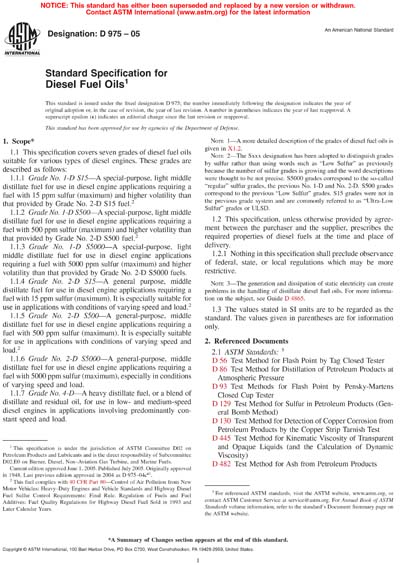Historical
ASTM D975-05
Standard Specification for Diesel Fuel Oils
1.1 This specification covers seven grades of diesel fuel oils suitable for various types of diesel engines. These grades are described as follows:
1.1.1 Grade No. 1-D S15A special-purpose, light middle distillate fuel for use in diesel engine applications requiring a fuel with 15 ppm sulfur (maximum) and higher volatility than that provided by Grade No. 2-D S15 fuel.²
1.1.2 Grade No. 1-D S500—A special-purpose, light middle distillate fuel for use in diesel engine applications requiring a fuel with 500 ppm sulfur (maximum) and higher volatility than that provided by Grade No. 2-D S500 fuel.²
1.1.3 Grade No. 1-D S5000—A special-purpose, light middle distillate fuel for use in diesel engine applications requiring a fuel with 5000 ppm sulfur (maximum) and higher volatility than that provided by Grade No. 2-D S5000 fuels.
1.1.4 Grade No. 2-D S15—A general purpose, middle distillate fuel for use in diesel engine applications requiring a fuel with 15 ppm sulfur (maximum). It is especially suitable for use in applications with conditions of varying speed and load.²
1.1.5 Grade No. 2-D S500—A general-purpose, middle distillate fuel for use in diesel engine applications requiring a fuel with 500 ppm sulfur (maximum). It is especially suitable for use in applications with conditions of varying speed and load.²
1.1.6 Grade No. 2-D S5000—A general-purpose, middle distillate fuel for use in diesel engine applications requiring a fuel with 5000 ppm sulfur (maximum), especially in conditions of varying speed and load.
1.1.7 Grade No. 4-D—A heavy distillate fuel, or a blend of distillate and residual oil, for use in low- and medium-speed diesel engines in applications involving predominantly constant speed and load.
Note 1—A more detailed description of the grades of diesel fuel oils is given in .
Note 2—The Sxxx designation has been adopted to distinguish grades by sulfur rather than using words such as "Low Sulfur" as previously because the number of sulfur grades is growing and the word descriptions were thought to be not precise. S5000 grades correspond to the so-called "regular" sulfur grades, the previous No. 1-D and No. 2-D. S500 grades correspond to the previous "Low Sulfur" grades. S15 grades were not in the previous grade system and are commonly referred to as "Ultra-Low Sulfur" grades or ULSD.
1.2 This specification, unless otherwise provided by agreement between the purchaser and the supplier, prescribes the required properties of diesel fuels at the time and place of delivery.
1.2.1 Nothing in this specification shall preclude observance of federal, state, or local regulations which may be more restrictive.
Note 3—The generation and dissipation of static electricity can create problems in the handling of distillate diesel fuel oils. For more information on the subject, see Guide D 4865.
1.3 The values stated in SI units are to be regarded as the standard. The values given in parentheses are for information only.
ASTM International [astm]

